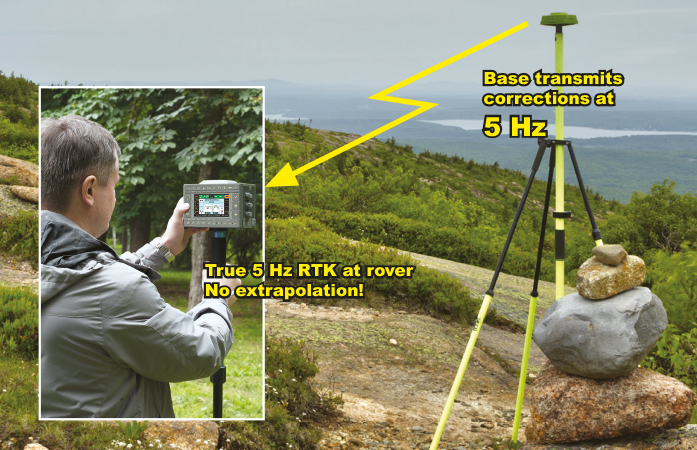Beast Mode True 5Hz RTK - Beast Mode RTK gets the job done faster and makes the improbable possible by getting fixed solutions five times faster.
In the open spaces, modern RTK engines from all manufacturers fix with impressive speed and reliability, often able to resolve ambiguities (i.e. “get a fixed solution”) in less than 10 seconds. In marginal spaces (the real world of land surveying), differences become more apparent, as various engines apply differing techniques for reducing multipath and determining the correct carrier wavelengths between the base and rover. In truly challenging environments, overhead tree canopy can make RTK entirely impotent.
Javad’s Beat Mode is like a turbocharger for RTK. Just as a turbocharger forces air into the cylinders of a combustion engine to improve output power, Beast Mode forces more reference station corrections into the RTK engine to produce fixes at the rover much, much faster. The improvement is virtually linear: in open, GNSS friendly environments, a fix time of about 10 seconds with corrections streaming in at a rate of once per second (1Hz) will be reduced to about 2 seconds when the corrections are increased to a rate of five times per second (5Hz).
The practical difference, while surveying in hospitable places, between 10 seconds and only two is minimal. However, in harsh environments with obstructions (satellite signals are blocked entirely) and multipath (satellite signals are reflected), fix times increase dramatically, often requiring several minutes for a single fixed solution, if the rover can resolve ambiguities at all. Along with time to fix, the need for redundancy to verify the fix requires time as well. In these situations, where surveyors find themselves most often, Beast Mode shines, as it reduces time to fix by 80%!
On-the-fly (OTF) initializations require synchronized corrections to the rover’s observation. If there is any latency in the correction, RTK cannot resolve ambiguities and the rover must wait until the next correction is available to attempt to fix. This is the significant difference between high rate correction transmission used by Beast Mode, and the high rate position solution offered by most GNSS manufacturers. Many rovers are capable of delivering positions at 20Hz or higher. These positions are extrapolated from the last fixed solution. If the fix is lost, these receivers must wait until a new correction is received before a fixed solution can be obtained. Regardless of the position rate, fix times will be no different from a position rate of 1Hz. A receiver with a position rate of 20Hz will require the same amount of time to fix as if the receiver were set to 1Hz. Furthermore, because these positions are extrapolated from the same correction, making each epoch between corrections highly correlated, their usefulness in averaging a position is minimal. It’s like averaging the same number again and again. Ten extrapolated positions will not be as robust as 10 positions using current corrections. Extrapolated positions are mostly useful for mobile applications, such as aerial photogrammetry and mobile scanning. Beast Mode’s high rate transmit, on the other hand, is not extrapolated. Five times per second, the rover is solving a position using synchronized base corrections. This makes each epoch much more useful for position averaging.
There are still many places a surveyor encounters that are simply not suitable for RTK. Surveyors must use discretion to judge which places are practical and which are not. Beast Mode RTK has reduced these shadowy places significantly by using brute force, turbocharging the RTK engine to perform in ways previously unknown.
Shawn Billings, RPLS
 Beast Mode RTK is available only via our TRIUMPH-2 and TRIUMPH-1M base station. It makes ambiguity
resolution up to 5 times faster because base station transmits base data 5 times per second. 5-Hz Beast Mode RTK
is totally different from the up to 100-Hz RTK that is done by extrapolating the same 1-Hz data 100 times per
second AFTER the ambiguities are fixed. This extrapolation technique does not improve the ambiguity resolution
speed and is mainly used in applications like machine control after the ambiguities are fixed.
Beast Mode RTK is available only via our TRIUMPH-2 and TRIUMPH-1M base station. It makes ambiguity
resolution up to 5 times faster because base station transmits base data 5 times per second. 5-Hz Beast Mode RTK
is totally different from the up to 100-Hz RTK that is done by extrapolating the same 1-Hz data 100 times per
second AFTER the ambiguities are fixed. This extrapolation technique does not improve the ambiguity resolution
speed and is mainly used in applications like machine control after the ambiguities are fixed.